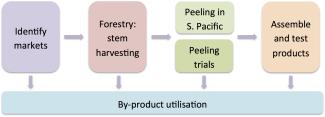The ACIAR-funded project aimed to develop the technologies, processes, and expertise to produce veneer and veneer-based products of various grades from senile coconut stems. Senile coconut stems are widespread and have very low value. Residues from the developed processes were used to develop soil conditioning products. In this phase of the project, livelihoods in South Pacific communities were enhanced through development of a valuable product from the senile stems.
The ACIAR-funded project FST/2009/062: Development of advanced veneer and other product from coconut wood to enhance livelihoods in South Pacific communities comprises research and extension activities developing the sustainable conversion of coconut stems in veneer and veneer- based products for export and for use in Pacific Island economies. The project supports economic development in Fiji, Samoa and the Solomon Islands.
The project aims to develop the technologies, processes and expertise to produce veneer and veneer-based products of various grades from senile coconut stems. Residues from the processes will be used to develop soil conditioning products. Senile coconut stems are widespread and have very low value. Livelihoods in South Pacific communities will be enhanced by developing a valuable product from the senile stems.
The project builds on the DAF-managed and ACIAR-funded project FST/2004/054, Improving value and marketability of coconut wood. That project concentrated on processing senile coconut stems into sawn boards for flooring and similar applications.
Assoc. Prof Gregory Nolan from the Centre for Sustainable Architecture with Wood (CSAW), University of Tasmania leads the project with Dr Henri Bailleres from the Queensland Department of Agriculture and Fisheries (DAF). Collaborating partners and collaborators in the project include: Secretariat of the Pacific Community (SPC), Fiji Department of Forests, Forest Research and Development Section, Forestry Division, Ministry of Natural resources, Samoa, Ministry of Forestry, the Solomon Islands, and industry in Australia and Pacific Islands.
Project Objectives
There are six project objectives:
- Identify the most promising product options for the veneer from coconut stem. This involved economic analysis of the value chain, product development, improvement of processing and marketing skills in the Pacfic, and increase in market apprrciation for cocowood veneer products in market centres.
- Provide viable protocols and developing capacity for effective and sustainable log supply, establishment of sustainable low-impact harvesting techniques and the compiling of acceptable plantation rehabilitation procedures and log grading, handling, preparation and transport protocols.
- Establish experimental veneer-peeling capacity in the South Pacific. This involved the acquirement of a spindle-less lathe equipment suite, optimisation of the lathe at DAF’s Salisbury Queensland research facility, commission of the lathe and support equipment at collaborator facilities in Fiji and assessment of the potential for a regional trial and demonstration program.
- Determine the optimum processing parameters and protocols for peeling coconut stems and the properties of the recovered veneer through determination of the primary characteristics of dry and graded veneer.
- Assemble the product suite and establish its characteristics and in-service performance in local and export markets - verified through material testings and monitored use in service.
- Develop uses for the cortex and soft, central cores remaining after logging and peeling; or by- product utilisation.
These objectives can be considered across five fields of research:
